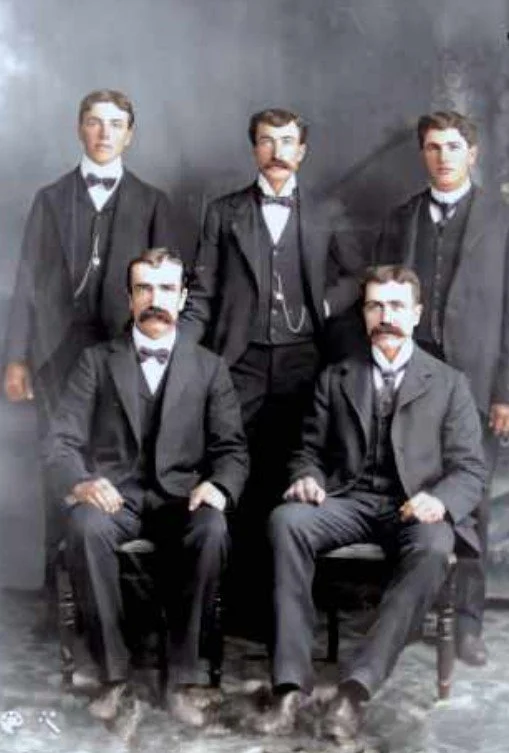Nailed Together by Love: The Gerber Boys’ Home for Eva
Eva Schübel Gerber: Polygamy & Pioneer Timeline
1865 — Eva Schübel marries John T. Gerber as his second wife.
1865–1887 — Eva and John build a life together and raise eight children.
March 1887 — John T. Gerber is arrested for “unlawful cohabitation” under anti-polygamy laws.
1887–1888 — John spends six months in prison.
1888 — John is released from prison. It is agreed he must end polygamy and return to his first wife, Anna Mary Rupp.
1888 — Young Eva and her sons — Samuel (22), Alma (18), George (16), Franklin (10), William (8) — work together to build her a separate home on ten acres deeded to her.
1890 — The LDS Church issues the Manifesto, officially ending the practice of plural marriage.
After 1890 — John and Eva live separately but remain neighbors on Gerber Lane, raising their children close by.
Eve’s sons Alma, Samuel, Frank, George, & William Gerber
Young Shoulders, Heavy Loads: The Gerber Boys’ Farm and Home
When the ruling came that ended plural marriage, Eva Schübel Gerber suddenly found herself alone with her children and ten acres of land — but she was not alone in spirit. Her sons, still so young, shouldered the work of grown men to keep the family going.
Eva had come to Utah as a brave teenage convert from Germany. She married John T. Gerber in 1865, becoming his second wife under the practice of plural marriage that the Church permitted at that time. Together, they raised eight children. But in 1887, John was arrested and spent six months in prison for “unlawful cohabitation,” as part of the government’s crackdown on polygamy. When he was released in 1888, it was agreed that he would end living as a plural husband — which meant Eva and her children would need a separate home of their own.
So, while John returned to live with his first wife, Anna Mary Rupp, young Eva and her sons faced the hard truth of going forward alone. About two years later, the 1890 LDS Manifesto formally ended polygamy, making the separation permanent in the eyes of the Church.
In 1888, when their mother needed a house of her own, the boys picked up hammers and saws after farm chores were done. They built sturdy walls and shingled a roof with rough lumber — not just for shelter, but as a promise that family could stand strong together. Her sons names & ages :Samuel (22), Alma (18), and George (16) , Franklin, only 10 years old, and William, just 8, worked alongside their older brothers, building Mother Eva a home.. They worked hard building the home….they already had seasoned hands. They rose before dawn to milk cows, tend horses and pigs, dig irrigation ditches, haul water for crops, and weed the garden that fed them all why building a home for the family.
It is just so inspiring that the minute mother needed a house of her own, the boys picked up hammers and saws after farm chores were done. They built sturdy walls and shingled a roof with rough lumber — not just for shelter, but as a promise that family could stand strong together. On that small farm on Gerber Lane, the Gerber boys learned early that sacrifice and sweat could build more than a house — they built hope for their mother and the future she dreamed for them.
Eva’s home still stands. It is back on what was once called Gerber lane : behind house 3838 S. 2200 W
This is the house Nailed Together by the Gerber Boys


